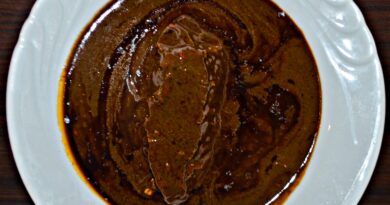Ogi
Unraveling the Timeless Tradition of Ogi: Nigeria’s Nourishing Fermented Porridge
Introduction: In the heart of Nigeria’s rich culinary tapestry lies a beloved dish that transcends generations, offering comfort, sustenance, and a taste of tradition. Ogi, also known as pap or akamu, is a fermented corn or millet porridge that has been a staple in Nigerian households for centuries. In this article, we explore the origins, preparation methods, nutritional benefits, cultural significance, and modern interpretations of this cherished West African delicacy, inviting you to discover the essence of Ogi and its enduring appeal.
Origins and Cultural Significance: The history of Ogi traces back to ancient times, where it was consumed by various ethnic groups across Nigeria as a nutritious and easily digestible meal. Made from locally sourced ingredients such as corn, millet, or sorghum, Ogi was traditionally prepared by soaking grains in water, allowing them to ferment naturally before being milled into a smooth, creamy porridge.
Beyond its nutritional value, Ogi holds cultural significance in Nigerian society, often served during special occasions, religious ceremonies, and family gatherings. It is cherished for its ability to bring people together, fostering a sense of community and connection through shared meals and culinary traditions.
Ingredients and Preparation: The ingredients for Ogi are simple yet essential, reflecting the resourcefulness and ingenuity of Nigerian cuisine. The basic components include:
- Corn, Millet, or Sorghum: The main grain used to make Ogi, providing carbohydrates, fiber, and essential nutrients.
- Water: Used for soaking and fermenting the grains, resulting in a smooth and creamy texture.
- Sugar or Sweeteners (optional): Added to enhance the sweetness of the porridge, according to personal preference.
- Flavorings: Ingredients such as ginger, cloves, or vanilla extract may be added for additional flavor and aroma.
The preparation of Ogi involves several steps, including soaking, fermenting, and cooking the grains to achieve the desired consistency. The process varies depending on regional preferences and family recipes, with some households opting for a thicker, more pudding-like texture, while others prefer a thinner, more liquid consistency.
Health Benefits: Ogi offers a multitude of health benefits, making it a nutritious choice for individuals of all ages. Some of its advantages include:
- Rich in Nutrients: Ogi is a good source of carbohydrates, vitamins, and minerals, including iron, calcium, and B-vitamins, essential for overall health and well-being.
- Easily Digestible: The fermentation process breaks down complex carbohydrates, making Ogi easier to digest and ideal for individuals with sensitive stomachs or digestive issues.
- Hydration: Ogi’s high water content helps keep the body hydrated, especially important in hot and humid climates.
- Satiety: The combination of carbohydrates and fiber in Ogi promotes feelings of fullness and satiety, helping to regulate appetite and prevent overeating.
- Versatility: Ogi can be customized with a variety of toppings and flavorings, allowing for endless culinary creativity and experimentation.
Cultural Significance: In Nigerian culture, Ogi holds a special place in daily life, serving as a symbol of hospitality, nourishment, and tradition. It is often enjoyed as a breakfast staple, served with toppings such as milk, sugar, honey, or groundnuts, offering a comforting start to the day.
Moreover, Ogi plays a significant role in cultural ceremonies and rites of passage, symbolizing purity, renewal, and community bonds. It is served during weddings, naming ceremonies, and religious festivals, where it is shared among family members, friends, and neighbors as a gesture of goodwill and unity.
Modern Interpretations: While Ogi remains deeply rooted in tradition, it has also evolved to adapt to modern tastes and lifestyles. Today, innovative chefs and home cooks are reinventing this classic dish, incorporating new flavors, textures, and ingredients to create contemporary interpretations of Ogi.
From savory variations infused with spices and herbs to sweet renditions adorned with fresh fruits and nuts, the possibilities for Ogi are endless. Its versatility and adaptability make it a favorite among food enthusiasts seeking both nostalgia and innovation in their culinary adventures.
Conclusion: In the vibrant tapestry of Nigerian cuisine, Ogi stands as a timeless tradition, a nourishing porridge that embodies the essence of community, culture, and culinary craftsmanship. From its humble origins to its modern interpretations, Ogi continues to captivate hearts and palates, offering a taste of tradition and a glimpse into the rich heritage of West Africa. So, why not savor the comforting embrace of Ogi and embark on a flavorful journey through Nigeria’s culinary landscape? With each spoonful, you’ll discover the warmth, depth, and enduring legacy of this beloved West African delicacy.



